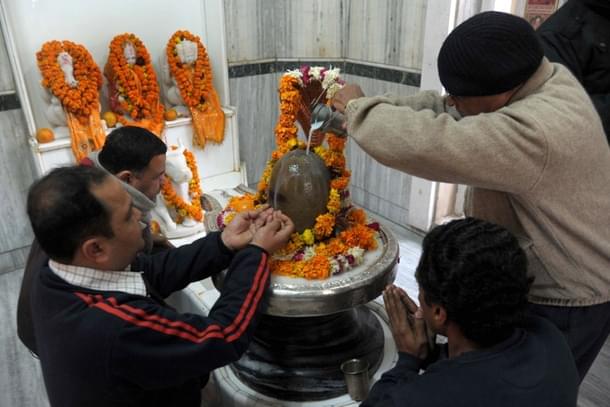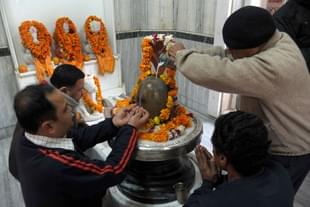Culture
What Some American Students Learn About Hinduism
Ramesh N Rao
Jun 28, 2015, 12:30 PM | Updated Feb 11, 2016, 10:20 AM IST
Save & read from anywhere!
Bookmark stories for easy access on any device or the Swarajya app.


Om Shri GurubhyoNamaha, Harihi Om!
Even though this column will not be about teaching the Vedas, let me begin with the invocation that is uttered as one begins the study of the Vedas. Of course, this invocation is also used when one chants the VishnuSahasranama and other shlokas, and I believe therefore is apt in the context of writing about education.
Having spent three decades in higher education here in the US it is time to say something about the nature of learning and teaching, of the vast changes occurring in the modes of delivering information and knowledge, of the kinds of teaching and teachers, and the taught and the unteachable, and surely something about the content that is imparted, not just in colleges and universities but in schools, kindergarten through the twelfth grade. Our ambit is large, and the matters are urgent and demanding of our attention, given the fact that India has more than 600 universities and more than 45,000 colleges and God only knows how many schools – primary, middle, and high – and the Indian education will go through change influenced by developments both within the country and elsewhere.
Elsewhere, for me, is the United States, where I have taught since 1987 across four states and in four universities. So, let me jump straight into an issue that I have been working on over the past month or so: a problem with a textbook for American students that has something to do with India.
This is not something new. The Hindu American Foundation (HAF) has engaged school textbook committees in the states of California, Texas, and Virginia in revising content about Hindus and Hinduism, Indian history and society: the challenge in getting revisions in place has been huge. The opposition came from members within Indian communities and from well-known academics in elite universities, as well as from politicians and activists. While I worked closely with the Hindu American Foundation on human rights issues, I observed my colleagues deal with the challenges of tackling entrenched forces who fought bitterly to make and keep Hinduism a “cult of the dead”, so to speak, with the focus of the textbooks being “caste, cow worship, dowry, and the status of women”.
While sixth grade students, for example, reading about Christianity or Islam, Sikhism or Buddhism learned only about what the prophets preached, what the religious books said about the nature of God and “man”, they found the social and cultural contexts that were highlighted in Hinduism completely missing in the discussion of other religions. HAF took the California State Board of Education to court, and over the past decade has collected a treasure trove of documents and information on these matters.
So, it should not have come as a surprise to me when I was comparing textbooks on intercultural communication (for students in the third or fourth year of college) and considering which textbook to adopt for teaching an online course on the subject. In one of the books, I was shocked to find the following description of Hinduism:
Hinduism is an inegalitarian, practice-based religion and is the third-largest religion after Christianity and Islam, with more than 1 billion followers. Unlike Christianity and Islam, Hinduism is not monotheistic (i.e., purporting a belief in a single god) and has no organized worship. Hinduism is practice based rather than faith-based, which means that practices — which are often social — are more important than beliefs. Jeff Spinner-Halev writes: ‘Hinduism is concerned with legitimizing hierarchical social relationships and mollifying deities, not with faith or belief. A Hindu may be atheist, pantheist, atheist, communist and believe whatever he likes, but what makes him into a Hindu are the ritual practices he performs and the rules to which he adheres, in short, what he does’. Unlike most of the Western approaches to ethics, Hinduism categorically denies that people are equal and practices a rigid caste system. A caste is a social ordering hierarchical system in which people are ranked. Hinduism prescribes strict rules and regulations about how one is to act within one’s caste level. In some cases, the lower caste may not be allowed even to interact with the higher caste. In India’s caste system, there are four levels: (1) Brahmins — the learned, educated elites, and priests; (2) Kshatriyas — the noble and warriors; (3) Vaishyas — the traders, businessmen, and farmers; and (4) Sudras — those who serve the needs of the upper-caste members. The Sudras are further divided into the touchable and Untouchables. The untouchable take on positions considered demeaning and polluting by the upper caste, such as barbers, hairdressers, or cleaners. The untouchable Sudras are considered spiritually polluting and perform jobs such as garbage collecting. Hinduism prescribes that one is born into a caste level and it is virtually impossible to move from one caste level to the next — that is, from lower to higher levels. In Hindu society, men and women are clearly not equal. The birth of a son is a blessing while the birth of a daughter is met with misgivings. She is a financial burden to the family.
That was it! No yoga and meditation, no Bhagavad Gita or the Shad Darshanas, no discussion about the influence of Hinduism on art, music, architecture, and dance in India, Southeast Asia, and also now in the West, and absolutely no mention of how some of the great American minds – Emerson and Thoreau, William James, and Huston Smith – responded to Hindu thought and belief. Interestingly, again, there was no such description of other religions, and the students did not get to read what Christianity, Islam, Judaism were all about. It was as if the author assumed that all American students were aware of and had a good knowledge of these religions, and only something “exotic” and “strange” as Hinduism needs to be explained.
If such a commentary on Hinduism was in an activist’s presentation at a hearing in the US Congress of the Gujarat riots of 2002, or in an editorial in The New York Times (whose editorial board seems to enjoy baiting Hindus) then one could dismiss it as par for the political/media course. However, in a book on intercultural communication, where the goal is to enable students to learn about other cultures so as to reduce bias, prejudice, ethnocentrism, and stereotypes when communicating and negotiating with others, this reductionist, crude, simplistic depiction of Hinduism would not just be wrong but unprofessional. That such a description of Hindus/Hinduism could be inserted into a textbook which went through numerous reviewers’ hands indicates the level and kinds of bias and prejudice that infect the work of scholars in the United States, not just in India – especially in the humanities and social sciences.
In India, with professors of a particular ideological bent at the helm for decades, the educating of young minds had been shaped by the will of the “left/progressive/secular” groups. Now, with the Bharatiya Janata Party in power in New Delhi, with loud dissent heard from within the ramparts of Jawaharlal Nehru University, and ominous and dire warnings about education “turning right in Hindutva mode” it is important that we not only discuss matters of history, religion, culture, and society thoroughly, but acknowledge the role of politics in shaping the writing about these matters. We need to prepare the ground for scholarly debate, tempered criticism and support a competitive marketplace of ideas. Recently, Sanjeev Sanyal has called for the rewriting of Indian history books, and one hopes that the Modi Government will choose a committee of experts carefully, who will lead the effort in bringing some balance, care, clarity, and integrity to educating Indian children and young adults.
Meanwhile, some of us will continue to challenge the biased narratives in media and academe here in the US, knowing that, as long as the Indian playing field is skewed, we will have an uphill battle to wage here.
Ramesh N Rao is Professor of Communication at Columbus State University, Columbus, GA. His latest book, co-authored with AvinashThombre, and published by Sage (India) is titled, “Intercultural Communication: The Indian Context”.
Ramesh N Rao is Professor, Department of Communication, Columbus State University





